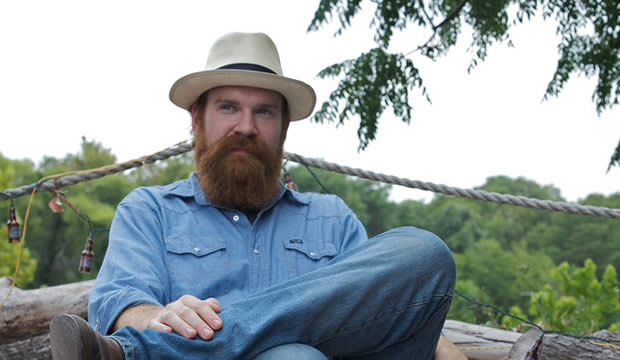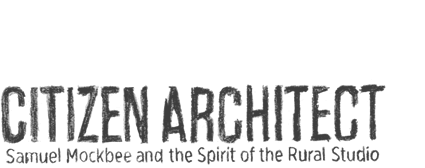Samuel Mockbee taught his students to use recycled and energy-efficient building materials.
More >
Q & A with Filmmaker Sam Wainwright Douglas

Buy the DVD here>
- You are Samuel Mockbee’s son-in-law. Aside from the family connection and access to the subject, what drove you and your wife, Sarah Ann, to work on and complete this film?
- SAM: I was always struck by the beauty and power of Sambo’s architecture and drawings. They had a lot of life and energy in them. But, more than that, I was inspired by the simple fact that he tried to make the world a better place with his talent, creativity and compassion. I think every artist wants to touch people the way Sambo was able to.
- My father and Sambo were friends and did several jobs together in the 80′s and 90′s, starting with the Mississippi Pavilion at the World’s Fair in New Orleans in 1984. As a kid growing up in Houston, I was quite taken by this big Mississippian with a huge beard who liked to draw as much as I did. And then, later on, I was blown away when I saw that he was making architecture not only for the usual crowd, but for everyone else and also engaging students to use their skills for something more fulfilling than just a paycheck. When I was a student at NYU, I would often drive through Mississippi on my way to school. Sambo always welcomed me into his home. We’d drink Heinekens and talk about art. He always had time to talk art.
- You’re in a grocery store checkout line, and you’re explaining to someone the legacy of Samuel Mockbee. Go!
- Samuel Mockbee was an architect who tried to make the world a better place through his creativity and compassion. He co-founded a program called the Rural Studio that invites architecture students to design and build striking, functional, respectful architecture for very impoverished communities in the rural South. He created an educational model that not only provides badly needed homes and facilities but also provides students with a seminal experience that leaves them bitten by the bug of incorporating a social responsibility into everything they do.
- When taking on a big personality like Mockbee’s – especially someone you were close to – what did you consider when making this film? What did you want to accomplish?
- We wanted to produce a film that followed a project from start to finish, so you could see the impact that the experience was having on students, while also allowing Mockbee to explain the Rural Studio and his motivations, allowing you to get to know this amiable, thoughtful person. We also tried to show his impact on the profession beyond the borders of Alabama and have a larger discussion about not only architecture’s role in our lives, but also education, citizenship, community strength and social priorities. And, we wanted to do it in an entertaining, thoughtful way that engages audiences beyond the architecture community.
- One of the funnier moments of the movie is when Peanut Robinson, a Hale County resident, tells Rural Studio’s Jay Sanders in no uncertain terms that architects don’t work for poor people and haven’t done anything for him or his community. Can you tell us how that scene came about and why you included it?
- Peanut sets up one of the main questions explored in the movie. Can architects have real impact? Is architecture just for the wealthy or can it benefit everybody? Peanut was very accommodating as far as filming went. He has a masters degree in education from Tuskegee and he loves to pontificate. So if you catch him in downtown Newbern, which you usually can, then he’ll be happy to strike a conversation with anyone who’s going to be respectful.
- One of film’s biggest strengths – you have never-before-seen interviews with Samuel Mockbee, speaking eloquently about his teaching philosophy and the effect of Rural Studio on students and the community. How did you get access to this? When were these interviews done?
- These interviews with Sambo were conducted at his home in Canton, MS in 1999. I’d been out of film school for a year. They were supposed to be a preliminary interview for a film on Sambo that I knew I wanted to do some day, which is why the production quality is a bit lacking. I thought we might just use them to get a grant or something. Sadly, Sambo passed away and these interviews ended up becoming the only candid, in-depth footage that exist of him on camera. It’s very fortunate that we have them for future generations.
- Can you talk about the Austin Film Society and how it helped you to shape your film?
- We live and work in Austin, Texas, and the Austin Film Society is very dedicated to and supportive of local filmmakers. It’s one of the only film organizations I’ve been a part of that makes the entire filmmaking community feel like a family. They provided us the opportunity to host several rough cut screenings to test the film on general audiences and fellow filmmakers. Without them, we could not have gotten as much feedback as you need when you’re making a film that appeals to a mainstream audience.
- Jimmy Lee Matthews, Music Man, is a central character in the film as Rural Studio students design and build a home for him and his collection of audio equipment. How would you describe Music Man’s life before, during and after the building of his new home?
- I don’t want to give away too much about Music Man and what happens to him in the film. Extreme poverty probably best describes his circumstances when the Rural Studio came into his life.
- In several moments in the film, we hear scholars and colleagues compare Samuel Mockbee’s very localized work with international architecture projects in places like Dubai. What’s your take on these comparisons?
- I want to leave that up to the viewer.
- You offer an alternative perspective to Samuel Mockbee’s thinking by interviewing Peter Eisenman, Yale professor and noted architect. Why did you choose to add this element? Was it difficult to get him to open up?
- We interviewed Mr. Eisenman so the audience can hear from someone who is on the other side of the architectural spectrum from Sambo. He is very sure of his opinions and was very forthcoming, which we really appreciated and respect. All we had to do was ask the question. He liked Sambo, but he approaches his work from a different point of view. It’s important to have multiple perspectives—it’s not about who’s right or who’s wrong—that’s the great thing about dialogues like this.
- It took a while to put this film together. What drove you to complete it?
- The year before Sambo passed away, he charged me and Jack Sanders with making a film that got to the heart of the Rural Studio. We had to honor that, and it’s a story we really cared about, so we never doubted we would get it done somehow. It has been 10 years since the initial interviews with Sambo, but I’m glad that the film has had the opportunity to explore his ongoing impact several years removed from that first footage. It’s a testament to his lasting impact and relevance.
- What kind of feedback have you gotten from architects and designers who have seen the film?
- Simply put, EVERYONE we’ve screened the film for leaves inspired and entertained… and they want more, which is why I’m grateful for this website. We hope to continue the conversation and engage those who want more.
- Can you talk about the groups that supported the making of this film – KRLU, CMPBS, AIA, Great Southern Wood – and what it means to you and creating a documentary in general?
- This has definitely been a collaborative effort and we are grateful for the generous support this film has received. KLRU provided support by shepherding us through the PBS system. We thank their general manager Bill Stotesbury for seeing the potential in this film and for letting us pull one of their producers, Dutch Rall, out of class on occasion to be our director of photography.
- The Center for Maximum Potential Building Systems (CMPBS) is headed up by Sambo’s friends and peers, Pliny Fisk III and Gail Vittori. They share similar concerns about the way we build our communities and were kind enough to act as our non-profit fiscal agent.
- We have to thank Deedie and Rusty Rose, who hired Sambo and Coleman Coker to design their ranch home, because they believed we were going to do what we set out to do and gave us the first funds to get our production going.
- Jim Ely helped us connect with national AIA. Jim and Sambo have been friends for over 30 years and he really took us under his wing. Likewise, one of Sambo’s star students, Bruce Lanier III, connected us with the Illges Foundation, which has generously supported this project and the Rural Studio.
- We could have never made this film without Great Southern Wood Preserving. Their CEO, Jimmy Rane, knew Sambo from their days at Marion Military Institute in Alabama. They have some really fun stories of walking penalty laps together—but that’s another story. Fast forward three decades and these two men are making a real difference in their communities. Jimmy really believes in the mission of the Rural Studio and has been a supporter of the program from the beginning.
- What’s your favorite part of the movie?
- I need to complete the final film and take some time away from it to figure that out.
- Just as the students become a part of the lives they change, did your filmmaking crew become a part of the lives you were filming, and if so, what were the effects?
- Definitely. We get calls from Music Man all the time. And we always hang out with him when we’re in Hale County. Music Man loves people. As he often says, he “ain’t never met a stranger.” So, if you ever head to Hale County, get a map of the Rural Studio projects from their Newbern headquarters and pay him a visit. His phone number is on the gate. Give him a call and take some dog food with you. You won’t regret it.

